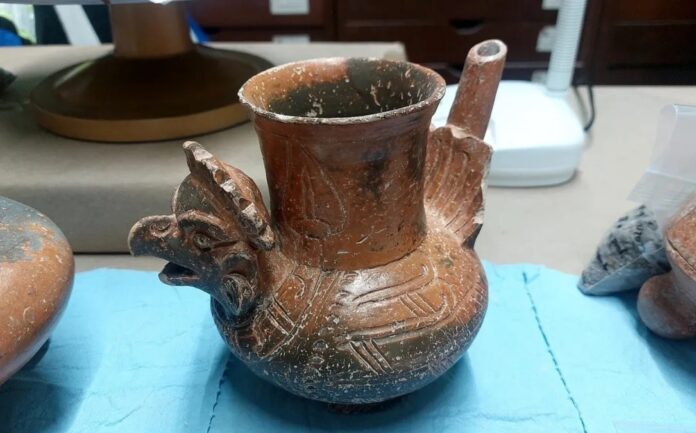The discovery highlights the complexity of the urban systems of communication and commerce that developed in the Maya area of Mesoamerica, which covers Mexico, Guatemala, Belize, Honduras and El Salvador.
The Mexican government found “the greatest archaeological treasure” of the last decades during the construction works of the Maya Train, in the southeast of the country, Diego Prieto Hernández, director of the National Institute of Anthropology and History (INAH), told EFE on Tuesday.
The solar disk in Chichén Itzá, the sculpture of the god of corn in Palenque, the dual stele in Uxmal, the bas-reliefs of a captive taken by the hair by a dignitary in Ek Balam, funerary urns and potsherds are some of the objects found in the five states that the new railway crosses.
“In Yucatán, Campeche, Quintana Roo, Tabasco and Chiapas we have discovered more than 1.4 million fragments of pottery, more than 50,000 movable and immovable goods, such as palaces and structures, constituting the greatest archaeological treasure found in the last decades in Mexico,” said the director of the INAH.
For the official, the important thing is to recover the integral information and the possibility of reconstructing social structures and the thought of the Maya.
“That is why they can have as much interest the tomb of Pakal, in Chiapas, as a spearhead that speaks of ancient presence of the culture of this region,” he explained.
The archaeologist highlighted the discovery of the complexity of the urban systems of communication and commerce that developed in the Maya area of Mesoamerica, which covers Mexico, Guatemala, Belize, Honduras and El Salvador.
To the cultural treasures found along the route of the Maya Train are added the rediscovery of Ichkabal, “a majestic city of the Maya nation that will open to the public in August next.”
“We are talking about great collective institutional research, with the participation of hundreds of young professionals in archaeology, technology, history and other disciplines,” he said.
When talking about the Program for the Improvement of Archaeological Zones (Promeza) derived from the Maya Train, he highlighted that they recovered “information and valuable material for a better knowledge of the evolution and development of the great Maya civilization, its epochs, cultural regions and artistic and urban expressions.”
The experts of the INAH generated new knowledge, “such as the high population density that was recorded in Mesoamerica, particularly in the north of Chiapas, the jungle of Tabasco, the south of Campeche and the Yucatan Peninsula.”
Prieto Hernández listed two pillars of that work of research and recovery of the Maya memory. “One, is the archaeological salvage that has to do with the recovery of materials that provide valuable information and structures of architectural order, but also movable and immovable goods in an area delimited by the rights of way of the train,” he said.
Another pillar is the Promeza, “in which we systematically and plannedly devoted ourselves to the research, conservation, structuring and stabilization of elements in archaeological zones open to the public and those that will open soon, such as Ichkabal,” he said.
The Promeza includes actions for a better experience of the visitors, “with elements of interpretation and understanding of the site, as well as basic services.”
The task of the INAH, which this 2024 turns 85 years old, is the research, conservation and dissemination.
“We cannot stay only with the research, we have to conserve the materials and archaeological sites for future generations,” he said.
Prieto Hernández pointed out that it is important to know that the Maya civilization has not disappeared, as it is constituted by linguistic variants and peoples who have resisted.
The treasures found during the construction of the Maya Train will be exhibited in the Archaeological Museums of the Puuc, of Site of Dzibilchaltún and Chichén Itzá, as well as the History Museum of Yucatán, which will open in the next months.
Source: La Prensa Grafica






